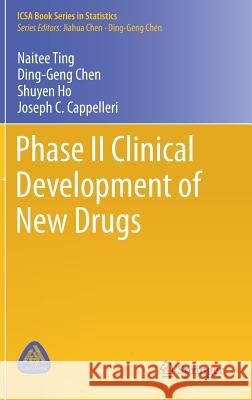Phase II Clinical Development of New Drugs » książka



Phase II Clinical Development of New Drugs
ISBN-13: 9789811041921 / Angielski / Twarda / 2017 / 241 str.
Phase II Clinical Development of New Drugs
ISBN-13: 9789811041921 / Angielski / Twarda / 2017 / 241 str.
(netto: 460,04 VAT: 5%)
Najniższa cena z 30 dni: 462,63
ok. 22 dni roboczych
Dostawa w 2026 r.
Darmowa dostawa!
This book focuses on how to appropriately plan and develop a Phase II program, and how to design Phase II clinical trials and analyze their data.
"It provides a hands-on approach to each subject, and the necessary statistical background is presented in the most non-mathematical way possible. ... Throughout the book, the scope of each subject is well defined, and if the reader has the need for further support, useful references are helpfully recommended. ... I would strongly recommend this book to anyone working in clinical development or with an interest in this field, regardless of their background." (David Manteigas, ISCB News, iscb.info, Issue 65, June, 2018)
Chapter 1 Introduction.- Chapter 2 Concept of Alpha.- Chapter 3 Confirmation and Exploration.- Chapter 4 Design a Proof of Concept (PoC) Trial.- Chapter 5 Design of Dose-Ranging Trials.- Chapter 6 Combining PoC and Dose Ranging Trials.- Chapter 7 Risks of Inconclusiveness.- Chapter 8 Analysis of a PoC Study.- Chapter 9 Data Analysis for Dose-Ranging Trials with Continuous Outcome.- Chapter 10 Data Analysis of Dose-Ranging Trials for Binary Outcomes.- Chapter 11 Bayesian Methods.- Chapter 12 Overview of Phase III Clinical Trials.
Naitee Ting is a Fellow of ASA. He is currently a Director in the Department of Biostatistics and Data Sciences at Boehringer-Ingelheim Pharmaceuticals Inc. (BI). He joined BI in September of 2009, and before joining BI, he was at Pfizer Inc. for 22 years (1987-2009). Naitee received his Ph.D. in 1987 from Colorado State University (major in Statistics). He has an M.S. degree from Mississippi State University (1979, Statistics) and a B.S. degree from College of Chinese Culture (1976, Forestry) at Taipei, Taiwan.
This book focuses on how to appropriately plan and develop a Phase II program, and how to design Phase II clinical trials and analyze their data. It provides a comprehensive overview of the entire drug development process and highlights key questions that need to be addressed for the successful execution of Phase II, so as to increase its success in Phase III and for drug approval. Lastly it warns project team members of the common potential pitfalls and offers tips on how to avoid them.
1997-2025 DolnySlask.com Agencja Internetowa
KrainaKsiazek.PL - Księgarnia Internetowa









